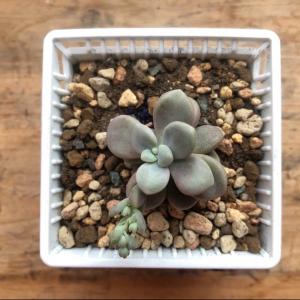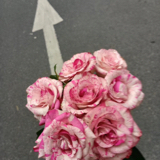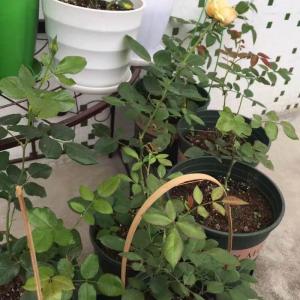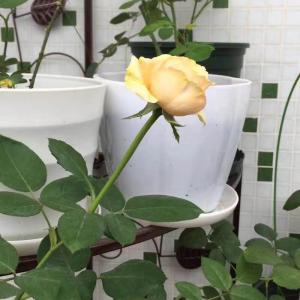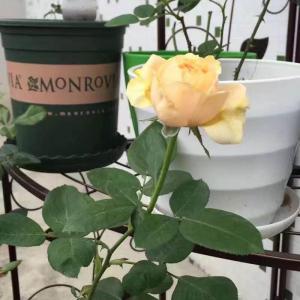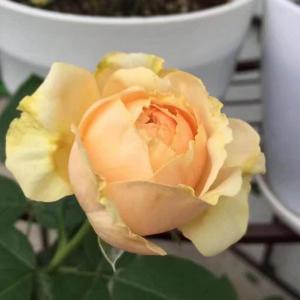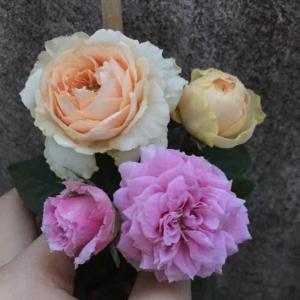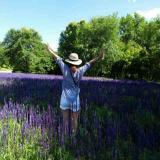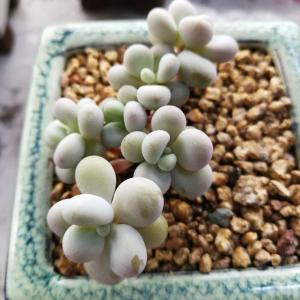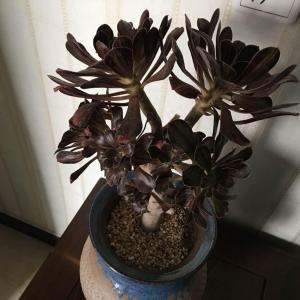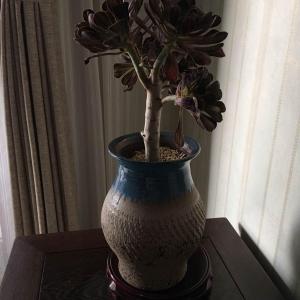文章
Miss Chen
2018年04月04日

Description: This perennial plant is 2-3' tall and little branched, except near the apex. The erect central stem is whitish green, bluntly 4-angled, and finely pubescent. The opposite leaves are up to 3" long and 1½" across; they are ovate in shape and crenate along their margins. The upper leaf surface is pale-medium or yellowish green and glabrous or nearly so (except for young leaves), while the lower leaf surface is whitish green and finely pubescent. The pubescence on the elevated veins of the leaf undersides is somewhat longer than the pubescence between the veins. The petioles are short (up to ½" in length), whitish green, and finely pubescent. From the middle to upper leaf axils, short secondary stems with smaller leaves may form.
Racemes of Flowers
The upper stems terminate in spike-like racemes of flowers up to 6" in length. These racemes are held upright and they have densely-spaced pairs of flowers. Each flower has a 2-lipped tubular corolla about ¾" long that is mostly blue-violet, and a short tubular calyx about ¼" long that is whitish green and finely pubescent. The reproductive organs of the flower are inserted within the corolla. The upper lip of the corolla is hood-like with lateral margins that are curled back, while its lower lip is larger and broader; there is a conspicuous patch of white in front of the throat of corolla. A very fine pubescence (canescence) covers the outer surface of the flower, particularly on the hood (visible with a 10x hand lens). The calyx has a conspicuous protuberance on its upper side. Both the central rachis of each raceme and the pedicels of the flowers (up to ¼" in length) are whitish green and finely pubescent. At the base of each pedicel on a raceme, there is a small leafy bract up to ½" long that is lanceolate or elliptic in shape. None of the hairs on this plant are glandular or sticky.

The blooming period occurs from mid- to late summer, lasting about 1-1½ months. There is no noticeable floral scent. The flowers are replaced by oddly shaped capsules that contain 2-4 nutlets. The upper surface of each capsule is concave with a protuberance on one side. At maturity, these capsules turn brown and split open to release their nutlets; this process may be facilitated by raindrop logistics. The root system is rhizomatous, often forming tight colonies of clonal plants.
Cultivation: The preference is partial sun and mesic to dry-mesic conditions. Full sun or light shade and moist conditions are also tolerated. The soil can contain loam, clay-loam, or some rocky material, which corresponds to the conditions in which this plant normally grows. Foliar disease rarely bothers this plant; some of the lower leaves may turn yellow and drop off the stem if there is a severe drought, but this member of the Mint family withstands dry conditions rather well. Occasionally, insects may chew holes in the leaves, sometimes causing major damage. Overall, this plant is easy to grow in a garden setting.

Range & Habitat: The native Downy Skullcap occurs occasionally in the southern half of Illinois, while in the rest of the state it is largely absent (see Distribution Map). Illinois lies along the northern range limit of this species. Habitats include upland forests, rocky slopes of woodlands, thinly wooded bluffs, rocky slopes along rivers, upland meadows in wooded areas, thickets, and roadsides that run through woodlands. Downy Skullcap usually occurs in and around upland forests, but it occasionally strays into adjacent meadows. This plant is usually found in higher quality natural areas.

Faunal Associations: The flowers are pollinated by bumblebees primarily, which suck nectar or collect pollen. Less common visitors are bee flies, skippers, or small butterflies, but these visitors are less likely to cross-pollinate the flowers. Some species of wasps may perforate the base of the flower and steal nectar (specifically, the Eumenid wasp Euodynerus foraminatus has been observed to do this), and Halictid bees sometimes take advantage of these perforations to suck nectar themselves. Insects that feed destructively on Downy Skullcap and other Skullcaps (Scutellaria spp.) include the flea beetles Phyllobrotica circumdata and Phyllobrotica limbata, the leaf-mining larvae of Caloptilia scutellariella (Skullcap Caloptilia Moth), and the larvae of Prochoreutis inflatella (Skullcap Skeletonizer Moth). Because the foliage is bitter-tasting and possibly toxic, mammalian herbivores usually don't bother this plant to any significant degree.

Photographic Location: The photographs were taken at the webmaster's wildflower garden in Urbana, Illinois.
Comments: Downy Skullcap has attractive foliage and flowers; it is one of the more showy species in this genus. It is similar to Agastache foeniculum (Anise Hyssop) in the appearance of its foliage and habitat preferences, but its flowers are larger and more attractive. Therefore, it's surprising that this plant is not grown in flower gardens more often. Distinguishing Scutellaria spp. (Skullcaps) is rather tricky, but here are some key characteristics of Downy Skullcap: 1) Except for the lowest leaves, the leaf bases are well-rounded, rather than heart-shaped; 2) this species of Skullcap blooms later and grows taller than most; 3) except for the upper leaf surfaces, the entire plant is finely pubescent, and it has no sticky glandular hairs; and 4) the racemes of its flowers are terminal, rather than axillary.
Racemes of Flowers
The upper stems terminate in spike-like racemes of flowers up to 6" in length. These racemes are held upright and they have densely-spaced pairs of flowers. Each flower has a 2-lipped tubular corolla about ¾" long that is mostly blue-violet, and a short tubular calyx about ¼" long that is whitish green and finely pubescent. The reproductive organs of the flower are inserted within the corolla. The upper lip of the corolla is hood-like with lateral margins that are curled back, while its lower lip is larger and broader; there is a conspicuous patch of white in front of the throat of corolla. A very fine pubescence (canescence) covers the outer surface of the flower, particularly on the hood (visible with a 10x hand lens). The calyx has a conspicuous protuberance on its upper side. Both the central rachis of each raceme and the pedicels of the flowers (up to ¼" in length) are whitish green and finely pubescent. At the base of each pedicel on a raceme, there is a small leafy bract up to ½" long that is lanceolate or elliptic in shape. None of the hairs on this plant are glandular or sticky.

The blooming period occurs from mid- to late summer, lasting about 1-1½ months. There is no noticeable floral scent. The flowers are replaced by oddly shaped capsules that contain 2-4 nutlets. The upper surface of each capsule is concave with a protuberance on one side. At maturity, these capsules turn brown and split open to release their nutlets; this process may be facilitated by raindrop logistics. The root system is rhizomatous, often forming tight colonies of clonal plants.
Cultivation: The preference is partial sun and mesic to dry-mesic conditions. Full sun or light shade and moist conditions are also tolerated. The soil can contain loam, clay-loam, or some rocky material, which corresponds to the conditions in which this plant normally grows. Foliar disease rarely bothers this plant; some of the lower leaves may turn yellow and drop off the stem if there is a severe drought, but this member of the Mint family withstands dry conditions rather well. Occasionally, insects may chew holes in the leaves, sometimes causing major damage. Overall, this plant is easy to grow in a garden setting.

Range & Habitat: The native Downy Skullcap occurs occasionally in the southern half of Illinois, while in the rest of the state it is largely absent (see Distribution Map). Illinois lies along the northern range limit of this species. Habitats include upland forests, rocky slopes of woodlands, thinly wooded bluffs, rocky slopes along rivers, upland meadows in wooded areas, thickets, and roadsides that run through woodlands. Downy Skullcap usually occurs in and around upland forests, but it occasionally strays into adjacent meadows. This plant is usually found in higher quality natural areas.

Faunal Associations: The flowers are pollinated by bumblebees primarily, which suck nectar or collect pollen. Less common visitors are bee flies, skippers, or small butterflies, but these visitors are less likely to cross-pollinate the flowers. Some species of wasps may perforate the base of the flower and steal nectar (specifically, the Eumenid wasp Euodynerus foraminatus has been observed to do this), and Halictid bees sometimes take advantage of these perforations to suck nectar themselves. Insects that feed destructively on Downy Skullcap and other Skullcaps (Scutellaria spp.) include the flea beetles Phyllobrotica circumdata and Phyllobrotica limbata, the leaf-mining larvae of Caloptilia scutellariella (Skullcap Caloptilia Moth), and the larvae of Prochoreutis inflatella (Skullcap Skeletonizer Moth). Because the foliage is bitter-tasting and possibly toxic, mammalian herbivores usually don't bother this plant to any significant degree.

Photographic Location: The photographs were taken at the webmaster's wildflower garden in Urbana, Illinois.
Comments: Downy Skullcap has attractive foliage and flowers; it is one of the more showy species in this genus. It is similar to Agastache foeniculum (Anise Hyssop) in the appearance of its foliage and habitat preferences, but its flowers are larger and more attractive. Therefore, it's surprising that this plant is not grown in flower gardens more often. Distinguishing Scutellaria spp. (Skullcaps) is rather tricky, but here are some key characteristics of Downy Skullcap: 1) Except for the lowest leaves, the leaf bases are well-rounded, rather than heart-shaped; 2) this species of Skullcap blooms later and grows taller than most; 3) except for the upper leaf surfaces, the entire plant is finely pubescent, and it has no sticky glandular hairs; and 4) the racemes of its flowers are terminal, rather than axillary.
0
0
文章
Miss Chen
2018年04月03日

Description: This woody vine produces stems up to 15' long that trail along the ground; some of the flowering stems are more erect and up to 4' tall. Old stems are brown and woody with scattered hooked prickles. Young stems are green with scattered hooked prickles; they are also more or less hairy. Alternate compound leaves occur at intervals along the stems. They are usually trifoliate with 3 leaflets; less often, compound leaves with 5 leaflets occur. These leaflets are up to 3" long and 1" across; they are ovate, doubly serrate along the margins, and mostly hairless. The underside of each leaflet is pale green, rather than white or velvety. Most leaflets have wedge-shaped bottoms and tips that taper gradually. The terminal leaflet has a short petiole (petiolule), while the lateral leaflets are sessile. Each compound leaf is connected to the stem by a long petiole. At the base of this petiole, there is a pair of small linear stipules.
Flowers & Leaflets
Young stems often terminate in a corymb of 1-5 flowers. Each flower is about 1-1¼" across when fully open; it consists of 5 white petals, 5 lanceolate green sepals, and numerous stamens that surround a green cluster of carpels. The petals are longer than the sepals and they often have a somewhat wrinkled appearance. The blooming period occurs from mid-spring to early summer and lasts about 1-2 months. The flowers open up during the day and close at night. Each fertilized flower is replaced by a compound drupe up to 1" long that is longer than it is broad. A fully ripened drupe becomes purple-black or black and it has a tart-sweet flavor. This drupe does not detach from its receptacle easily. The root system consists of a woody taproot. This woody vine spreads by reseeding itself; sometimes, the tips of young stems will root in the ground, forming vegetative offsets.

Cultivation: This plant typically grows in full to partial sun and mesic to dry conditions. It tolerates different kinds of soil, including those containing loam, clay-loam, sand, or rocky material.
Range & Habitat: The native Common Dewberry is common in the southern half of Illinois; it is less common or absent in the northern half of the state, particularly in the NW area (see Distribution Map). Habitats include mesic to dry savannas and sandy savannas, woodland borders, meadows in wooded areas, and abandoned fields. Common Dewberry is found in both sandy and non-sandy habitats. Occasional wildfires that remove tall woody vegetation tend to increase the population of Common Dewberry.

Faunal Associations: The flowers attract both long-tongued and short-tongued bees, including honeybees, bumblebees, Mason bees, Leaf-Cutting bees, Cuckoo bees (Nomadine), and Miner bees (Eucerine). These insects suck nectar or collect pollen. The flowers also attract butterflies, skippers, and various flies. Insects that feed on various parts of Common Dewberry and other Rubus spp. include Siphonophora rubi (Blackberry Aphid; sucks juices), Edwardsiana rosae (Rose Leafhopper; sucks juices), Metallus rubi (Blackberry Leafminer; sawfly maggot tunnels through leaves), Agrilus ruficollis (Red-Necked Cane Borer; beetle grub bores through stems), and the caterpillars of many moths. The drupes of Common Dewberry and other Rubus spp. are an important source of summer food to many upland gamebirds and songbirds (see Bird Table). The Raccoon, Fox Squirrel, Eastern Chipmunk, White-Footed Mouse, and other mammals also eat the fruits, while the Cottontail Rabbit and White-Tailed Deer browse on the leaves and stems.

Photographic Location: A meadow in a wooded area at Orchid Hill in Vermilion County, Illinois; a sandy meadow at Irwin Prairie State Nature Preserve in Lucas County, Ohio; and the Indiana Dunes State Park in NW Indiana.
Comments: The compound drupes (fruits) of Common Dewberry are edible to humans; when they are fully ripened, their flavor is pleasant. Common Dewberry can be distinguished from most Rubus spp. (Blackberries) by its vine-like habit. There are other Rubus spp. that are woody vines in various areas of the state, but they are less common. One of them, Rubus trivialis (Southern Dewberry) is restricted to southern Illinois. Its appearance and growth habit is similar to Common Dewberry, but the young stems of Southern Dewberry usually have sharp bristles and prickles. The young stems of Common Dewberry have soft hairs and prickles, but not sharp bristles. The leaves of Southern Dewberry are evergreen, while those of Common Dewberry are deciduous. The appearance of Common Dewberry is somewhat variable across its broad range, although different varieties have not been described for Illinois.
Flowers & Leaflets
Young stems often terminate in a corymb of 1-5 flowers. Each flower is about 1-1¼" across when fully open; it consists of 5 white petals, 5 lanceolate green sepals, and numerous stamens that surround a green cluster of carpels. The petals are longer than the sepals and they often have a somewhat wrinkled appearance. The blooming period occurs from mid-spring to early summer and lasts about 1-2 months. The flowers open up during the day and close at night. Each fertilized flower is replaced by a compound drupe up to 1" long that is longer than it is broad. A fully ripened drupe becomes purple-black or black and it has a tart-sweet flavor. This drupe does not detach from its receptacle easily. The root system consists of a woody taproot. This woody vine spreads by reseeding itself; sometimes, the tips of young stems will root in the ground, forming vegetative offsets.

Cultivation: This plant typically grows in full to partial sun and mesic to dry conditions. It tolerates different kinds of soil, including those containing loam, clay-loam, sand, or rocky material.
Range & Habitat: The native Common Dewberry is common in the southern half of Illinois; it is less common or absent in the northern half of the state, particularly in the NW area (see Distribution Map). Habitats include mesic to dry savannas and sandy savannas, woodland borders, meadows in wooded areas, and abandoned fields. Common Dewberry is found in both sandy and non-sandy habitats. Occasional wildfires that remove tall woody vegetation tend to increase the population of Common Dewberry.

Faunal Associations: The flowers attract both long-tongued and short-tongued bees, including honeybees, bumblebees, Mason bees, Leaf-Cutting bees, Cuckoo bees (Nomadine), and Miner bees (Eucerine). These insects suck nectar or collect pollen. The flowers also attract butterflies, skippers, and various flies. Insects that feed on various parts of Common Dewberry and other Rubus spp. include Siphonophora rubi (Blackberry Aphid; sucks juices), Edwardsiana rosae (Rose Leafhopper; sucks juices), Metallus rubi (Blackberry Leafminer; sawfly maggot tunnels through leaves), Agrilus ruficollis (Red-Necked Cane Borer; beetle grub bores through stems), and the caterpillars of many moths. The drupes of Common Dewberry and other Rubus spp. are an important source of summer food to many upland gamebirds and songbirds (see Bird Table). The Raccoon, Fox Squirrel, Eastern Chipmunk, White-Footed Mouse, and other mammals also eat the fruits, while the Cottontail Rabbit and White-Tailed Deer browse on the leaves and stems.

Photographic Location: A meadow in a wooded area at Orchid Hill in Vermilion County, Illinois; a sandy meadow at Irwin Prairie State Nature Preserve in Lucas County, Ohio; and the Indiana Dunes State Park in NW Indiana.
Comments: The compound drupes (fruits) of Common Dewberry are edible to humans; when they are fully ripened, their flavor is pleasant. Common Dewberry can be distinguished from most Rubus spp. (Blackberries) by its vine-like habit. There are other Rubus spp. that are woody vines in various areas of the state, but they are less common. One of them, Rubus trivialis (Southern Dewberry) is restricted to southern Illinois. Its appearance and growth habit is similar to Common Dewberry, but the young stems of Southern Dewberry usually have sharp bristles and prickles. The young stems of Common Dewberry have soft hairs and prickles, but not sharp bristles. The leaves of Southern Dewberry are evergreen, while those of Common Dewberry are deciduous. The appearance of Common Dewberry is somewhat variable across its broad range, although different varieties have not been described for Illinois.
0
0
文章
Miss Chen
2018年04月02日

Description: This is a woody vine that is 4-12' long. In open areas, the Climbing Wild Rose ascends about 3' and arches downward to reroot in the ground, while in more wooded areas it tends to climb over neighboring vegetation. The prickles along the woody stems are short, stout, and slightly curved. They are not particularly numerous. The alternate compound leaves usually consist of 3 leaflets, or less often 5 leaflets. Each leaflet is about 2-3" long and 1-1½" across, with a rather long and pointed tip. The shape is ovate to slightly lanceolate, with deep conspicuous veins, and finely serrate margins. At the base of each compound leaf are two winged stipules without comb-like hairs.

The flowers appear in small clusters from early to mid-summer and bloom for about a month. Each flower is about 2½-3" across, and consists of 5 light pink to rosy pink petals, numerous golden stamens, and pistils that form a small column in the center. The flowers have a typical rose fragrance. Later in the summer, bright red rose hips appear. The root system consists of a taproot that branches occasionally, and is usually quite deep. This vine reproduces by seed or suckering of the stems.
Cultivation: The preference is full or partial sun and loamy, fertile soil. This plant prefers soil that is evenly moist or mesic – it dislikes wet conditions with standing water or droughty conditions. During dry, hot weather there is a tendency for the leaves to become yellowish green and growth may be stunted.

Range & Habitat: The native Climbing Wild Rose occurs throughout most of Illinois, except in the NW, where it is uncommon or absent (see Distribution Map). Habitats include moist to mesic prairies, savannas, thickets, woodland borders and clearings, acid gravel seeps, fence rows, abandoned pastures, and waste areas. Sometimes this plant is called the 'Prairie Rose,' although it is more common near woodland areas. It has a moderate capacity to recover from occasional fire and other disturbances.
Faunal Associations: The most common visitors to the flowers are various bees and Syrphid flies. Bees collect pollen, and typical visitors include honeybees, bumblebees, Anthophorine bees, Miner bees, large Leaf-Cutting bees, and Halictine bees. Syrphid flies feed on pollen, and are not effective pollinators. Various beetles and moth caterpillars feed on the foliage and flowers (see Moth Table for the latter). In some areas, Japanese Beetles can be troublesome. The rose hips are eaten by various small mammals and birds, including the Greater Prairie Chicken, while the stems and foliage are browsed by the Cottontail Rabbit and White-Tailed Deer (particularly the latter), notwithstanding the occasional prickles.
Photographic Location: The photographs were taken at a powerline clearance of Busey Woods in Urbana, Illinois.
Comments: This native rose can be distinguished from the exotic Rosa multiflora (Multiflora Rose) by the lack of comb-like hairs on the stipules at the base of its compound leaves. It also differs from Multiflora Rose by having larger flowers that are more pink and by having fewer leaflets per compound leaf. Other native roses in Illinois are small shrubs that don't have the climbing habit of Rosa setigera (Wild Climbing Rose). They also have more leaflets per compound leaf than the latter species, and they have a flat button of pistils at the center of each flower, instead of a narrow column of pistils.

The flowers appear in small clusters from early to mid-summer and bloom for about a month. Each flower is about 2½-3" across, and consists of 5 light pink to rosy pink petals, numerous golden stamens, and pistils that form a small column in the center. The flowers have a typical rose fragrance. Later in the summer, bright red rose hips appear. The root system consists of a taproot that branches occasionally, and is usually quite deep. This vine reproduces by seed or suckering of the stems.
Cultivation: The preference is full or partial sun and loamy, fertile soil. This plant prefers soil that is evenly moist or mesic – it dislikes wet conditions with standing water or droughty conditions. During dry, hot weather there is a tendency for the leaves to become yellowish green and growth may be stunted.

Range & Habitat: The native Climbing Wild Rose occurs throughout most of Illinois, except in the NW, where it is uncommon or absent (see Distribution Map). Habitats include moist to mesic prairies, savannas, thickets, woodland borders and clearings, acid gravel seeps, fence rows, abandoned pastures, and waste areas. Sometimes this plant is called the 'Prairie Rose,' although it is more common near woodland areas. It has a moderate capacity to recover from occasional fire and other disturbances.
Faunal Associations: The most common visitors to the flowers are various bees and Syrphid flies. Bees collect pollen, and typical visitors include honeybees, bumblebees, Anthophorine bees, Miner bees, large Leaf-Cutting bees, and Halictine bees. Syrphid flies feed on pollen, and are not effective pollinators. Various beetles and moth caterpillars feed on the foliage and flowers (see Moth Table for the latter). In some areas, Japanese Beetles can be troublesome. The rose hips are eaten by various small mammals and birds, including the Greater Prairie Chicken, while the stems and foliage are browsed by the Cottontail Rabbit and White-Tailed Deer (particularly the latter), notwithstanding the occasional prickles.
Photographic Location: The photographs were taken at a powerline clearance of Busey Woods in Urbana, Illinois.
Comments: This native rose can be distinguished from the exotic Rosa multiflora (Multiflora Rose) by the lack of comb-like hairs on the stipules at the base of its compound leaves. It also differs from Multiflora Rose by having larger flowers that are more pink and by having fewer leaflets per compound leaf. Other native roses in Illinois are small shrubs that don't have the climbing habit of Rosa setigera (Wild Climbing Rose). They also have more leaflets per compound leaf than the latter species, and they have a flat button of pistils at the center of each flower, instead of a narrow column of pistils.
0
0
文章
Miss Chen
2018年04月02日

Description: This woody shrub is about 2-4' tall, branching occasionally. Young branches are green, but older branches become grey or brown and woody. The branches have two different kinds of thorns: large straight thorns (about ½" or longer) that are reddish brown and small straight thorns (¼" or less) that are brown. The large thorns occur in bunches of 1-3 where the petioles of the leaves occur (or used to occur), while the small thorns are abundant on the larger branches. However, smaller branches may lack small thorns altogether. The deciduous leaves occur alternately along the stems in bunches of 1-3. Each leaf is up to 2" long and across and palmately lobed; there are 3-5 major lobes and several smaller lobes (or large teeth that are crenate). Each lobe is cleft and tapers to a blunt point. The base of each leaf is slightly cordate, truncate, or obtuse. The upper surface of each leaf is hairless to slightly pubescent, while the lower surface is nearly hairless to pubescent. The petiole of each leaf is somewhat hairy and about 1–1½" long.

Near the base of some leaf petioles, a raceme or corymb of 1-3 flowers is produced. The stalk of this inflorescence spreads horizontally, while the flowers droop downward on slender pedicels. Each flower has a narrow tubular calyx with 4-5 linear-oblong lobes, a similar number of strongly exerted stamens, and a smooth ovary at its base; this flower is up to ½" long (including the stamens). The tubular calyx and its lobes are white (sometimes tinted green or purple); the stamens are at least twice as long as the tubular calyx. The blooming period occurs during late spring and lasts about 2 weeks. Each fertilized flower is replaced by a globoid berry about 1/3" (8 mm.) across or a little larger; this berry is initially green and glabrous, but it later becomes dull red or dull purple. There are no prickles on the surface. The berries are juicy and contain many minute seeds. The root system is woody and branching.

Cultivation: The preference is partial sun, mesic to slightly dry conditions, and loamy or rocky soil with organic material to retain moisture. In excessive shade, flowers and fruit may not be produced. Gooseberries and currants (both Ribes spp.) can be hosts to White Pine blister rust. This is not usually a problem in Illinois, as White Pine and its relatives occur in boreal areas to the north of the state.
Range & Habitat: The native Missouri Gooseberry is occasional to locally common in central, northern, and SW Illinois, but it is absent in the SE and south-central areas of the state (see Distribution Map). Habitats include mesic to dry open woodlands, savannas, woodland borders, thickets, powerline clearances and small meadows in wooded areas, abandoned fields, and partially shaded fence rows. Occasional disturbance is beneficial if it removes some of the overhead tree canopy.

Faunal Associations: The nectar and pollen of the flowers attract bees primarily; this includes both long-tongued and short-tongued bees. Less common insect visitors include flies, butterflies, Hummingbird moths, and wasps. Bees with long-tongues are more effective at pollinating the flowers than other visitors. Examples of such bees are bumblebees, Anthophorid bees, Mason bees, and Digger bees (Eucerine). The caterpillars of the butterflies Polygonia faunus (Green Comma) and Polygonia progne (Gray Comma) feed on the foliage of Ribes spp. (Gooseberries, Currants). The Insect Table lists other species that feed on Gooseberries and Currants. The fruit is occasionally eaten by some songbirds, including the Catbird, Robin, Brown Thrasher, and Cedar Waxwing. The fruit is also eaten by some mammals, including the Red Fox, Eastern Skunk, Raccoon, Red Squirrel, Deer Mouse, and White-Footed Mouse. These animals help to distribute the seeds to new locations.
Photographic Location: The edge of a deciduous woodland at Busey Woods in Urbana, Illinois. The fruit in the lower photograph is still green.
Leaf Underside & Fruit
Comments: This is the most common Gooseberry in Illinois (excluding cultivated forms). Like many other Gooseberries, it is a rather spiny shrub with palmately cleft leaves and odd drooping flowers. Missouri Gooseberry differs from Ribes cynosbati (Prickly Gooseberry), a less common species in Illinois, by the smooth surface of its berries; the latter has berries with a conspicuously prickly surface. The leaf bases of Prickly Gooseberry are usually more cordate than those of Missouri Gooseberry, and the stamens of its flowers are not exerted beyond the tubular calyx. Another species, Ribes hirtellum (Northern Gooseberry), is restricted to northern Illinois. This species has yellowish green flowers with tubular calyxes that are more broad, and its exerted stamens are up to twice the length of the corollas. Missouri Gooseberry has flowers that are more or less white; they have narrow tubular calyxes with exerted stamens that are at least twice the length of the calyx tubes (excluding their lobes). The branches of Missouri Gooseberry are usually more thorny than those of Northern Gooseberry; the larger thorns of the former are ½" or more in length, while the thorns of the latter are less than ½" in length.

Near the base of some leaf petioles, a raceme or corymb of 1-3 flowers is produced. The stalk of this inflorescence spreads horizontally, while the flowers droop downward on slender pedicels. Each flower has a narrow tubular calyx with 4-5 linear-oblong lobes, a similar number of strongly exerted stamens, and a smooth ovary at its base; this flower is up to ½" long (including the stamens). The tubular calyx and its lobes are white (sometimes tinted green or purple); the stamens are at least twice as long as the tubular calyx. The blooming period occurs during late spring and lasts about 2 weeks. Each fertilized flower is replaced by a globoid berry about 1/3" (8 mm.) across or a little larger; this berry is initially green and glabrous, but it later becomes dull red or dull purple. There are no prickles on the surface. The berries are juicy and contain many minute seeds. The root system is woody and branching.

Cultivation: The preference is partial sun, mesic to slightly dry conditions, and loamy or rocky soil with organic material to retain moisture. In excessive shade, flowers and fruit may not be produced. Gooseberries and currants (both Ribes spp.) can be hosts to White Pine blister rust. This is not usually a problem in Illinois, as White Pine and its relatives occur in boreal areas to the north of the state.
Range & Habitat: The native Missouri Gooseberry is occasional to locally common in central, northern, and SW Illinois, but it is absent in the SE and south-central areas of the state (see Distribution Map). Habitats include mesic to dry open woodlands, savannas, woodland borders, thickets, powerline clearances and small meadows in wooded areas, abandoned fields, and partially shaded fence rows. Occasional disturbance is beneficial if it removes some of the overhead tree canopy.

Faunal Associations: The nectar and pollen of the flowers attract bees primarily; this includes both long-tongued and short-tongued bees. Less common insect visitors include flies, butterflies, Hummingbird moths, and wasps. Bees with long-tongues are more effective at pollinating the flowers than other visitors. Examples of such bees are bumblebees, Anthophorid bees, Mason bees, and Digger bees (Eucerine). The caterpillars of the butterflies Polygonia faunus (Green Comma) and Polygonia progne (Gray Comma) feed on the foliage of Ribes spp. (Gooseberries, Currants). The Insect Table lists other species that feed on Gooseberries and Currants. The fruit is occasionally eaten by some songbirds, including the Catbird, Robin, Brown Thrasher, and Cedar Waxwing. The fruit is also eaten by some mammals, including the Red Fox, Eastern Skunk, Raccoon, Red Squirrel, Deer Mouse, and White-Footed Mouse. These animals help to distribute the seeds to new locations.
Photographic Location: The edge of a deciduous woodland at Busey Woods in Urbana, Illinois. The fruit in the lower photograph is still green.
Leaf Underside & Fruit
Comments: This is the most common Gooseberry in Illinois (excluding cultivated forms). Like many other Gooseberries, it is a rather spiny shrub with palmately cleft leaves and odd drooping flowers. Missouri Gooseberry differs from Ribes cynosbati (Prickly Gooseberry), a less common species in Illinois, by the smooth surface of its berries; the latter has berries with a conspicuously prickly surface. The leaf bases of Prickly Gooseberry are usually more cordate than those of Missouri Gooseberry, and the stamens of its flowers are not exerted beyond the tubular calyx. Another species, Ribes hirtellum (Northern Gooseberry), is restricted to northern Illinois. This species has yellowish green flowers with tubular calyxes that are more broad, and its exerted stamens are up to twice the length of the corollas. Missouri Gooseberry has flowers that are more or less white; they have narrow tubular calyxes with exerted stamens that are at least twice the length of the calyx tubes (excluding their lobes). The branches of Missouri Gooseberry are usually more thorny than those of Northern Gooseberry; the larger thorns of the former are ½" or more in length, while the thorns of the latter are less than ½" in length.
0
0
文章
Miss Chen
2018年04月02日

Description: This woody shrub is about 2-4' tall, branching occasionally. Young branches are green, while older branches are grey or brown. They have two kinds of thorns: long thorns about ½" long that occur in groups of 1-3 near the petioles of the leaves (or where the petioles used to be located), and shorter thorns about ¼" or less that are abundant on major branches, but fewer in number or absent on smaller branches. These thorns are straight and brown to reddish brown. The leaves occur alternately along the branches in groups of 1-3. Each leaf is up to 2" long and across; it is palmately lobed and crenate along the margins. There are usually 3-5 major lobes per leaf, and several lesser lobes; they are cleft and taper to blunt tips. The upper surface of each leaf is slightly pubescent to hairless, while the lower surface is pubescent to slightly pubescent. Each leaf is cordate (indented) at the base where the petiole joins the blade. The petioles are usually hairy and up to 1½" long. Flowers are produced in groups of 1-3 near the petioles of some leaves; the inflorescence is either a branched cyme or a short raceme, from which the flowers droop downward. The slender pedicels of the flowers are green and pubescent or slightly hairy.
Each flower is about 1/3" (8 mm.) long and greenish yellow; it consists of short tubular calyx with 4-5 spreading lobes, a similar number of stamens, and a prickly or bristly ovary underneath. The short lobes are oblong to oval in shape, while the stamens extend no farther than the tubular calyx (they are not exerted). The petals are smaller than the calyx lobes and insignificant. The blooming period occurs during late spring and lasts about 2 weeks. Each fertilized flower develops into a globoid berry about 1/3" (8 mm.) across or a little larger. Immature berries are shiny and green, but they later become dull red or dull purple. All berries have conspicuous prickles. The berries are juicy and contain several minute seeds. The root system is branching and woody.
Cultivation: The preference is partial sun, mesic to dry conditions, and loamy or rocky soil. In excessive shade, flowers and fruit may fail to develop. Gooseberries and currants (Ribes spp.) are alternate hosts to White Pine Blister rust.

Range & Habitat: The native Prickly Gooseberry occurs occasionally in central and northern Illinois, while in the southern part of the state it is uncommon or absent (see Distribution Map). Habitats include thin rocky woodlands, wooded slopes, woodland borders, and limestone bluffs. Some disturbance is beneficial to this species if it reduces the overhead tree canopy.
Faunal Associations: The flowers attract honeybees, bumblebees, Large Carpenter bees, Andrenid bees, Syrphid flies, and various ants; most of these visitors suck nectar from the flowers, although Andrenid bees also collect pollen. The bees are more effective pollinators than either flies or ants. The caterpillars of the butterflies Polygonia faunus (Green Comma) and Polygonia progne (Gray Comma) feed on the foliage of Ribes spp. (Gooseberries, Currants). The Insect Table lists additional insects that feed on gooseberries and currants. Some songbirds eat the fruit, including the Catbird, Robin, Brown Thrasher, and Cedar Waxwing. Various mammals eat the fruit as well, including the Red Fox, Raccoon, Striped Skunk, Red Squirrel, Deer Mouse, and White-Footed Mouse. These animals help to distribute the seeds to new locations. To some extent, White-Tailed Deer browse on the branches and leaves, notwithstanding the presence of thorns.

Photographic Location: A rocky bluff with oak trees in Vermilion County, Illinois. In the photograph of leafy branches, there is some evidence of browsing by deer.
Comments: The most striking feature of this shrub is its prickly berries. It is unclear what advantage this provides in comparison to berries without prickles. Other species of plants produce prickly fruits as well – e.g., some Opuntia spp. (Prickly Pear Cacti) have prickly fruits that are offered for sale in grocery stores. In addition to its prickly berries, Prickly Gooseberry can be distinguished from other Ribes spp. (Gooseberries) by the inserted stamens of its flowers and leaves with indented bases (cordate). Other Gooseberries in Illinois have non-prickly berries, flowers with exerted stamens, and leaf bases that are truncate, rounded (obtuse), or less indented. Those Ribes spp. that are Currants have larger clusters of flowers/berries (5 or more). Prickly Gooseberry is more common in areas that are located to the north and east of Illinois.
Each flower is about 1/3" (8 mm.) long and greenish yellow; it consists of short tubular calyx with 4-5 spreading lobes, a similar number of stamens, and a prickly or bristly ovary underneath. The short lobes are oblong to oval in shape, while the stamens extend no farther than the tubular calyx (they are not exerted). The petals are smaller than the calyx lobes and insignificant. The blooming period occurs during late spring and lasts about 2 weeks. Each fertilized flower develops into a globoid berry about 1/3" (8 mm.) across or a little larger. Immature berries are shiny and green, but they later become dull red or dull purple. All berries have conspicuous prickles. The berries are juicy and contain several minute seeds. The root system is branching and woody.
Cultivation: The preference is partial sun, mesic to dry conditions, and loamy or rocky soil. In excessive shade, flowers and fruit may fail to develop. Gooseberries and currants (Ribes spp.) are alternate hosts to White Pine Blister rust.

Range & Habitat: The native Prickly Gooseberry occurs occasionally in central and northern Illinois, while in the southern part of the state it is uncommon or absent (see Distribution Map). Habitats include thin rocky woodlands, wooded slopes, woodland borders, and limestone bluffs. Some disturbance is beneficial to this species if it reduces the overhead tree canopy.
Faunal Associations: The flowers attract honeybees, bumblebees, Large Carpenter bees, Andrenid bees, Syrphid flies, and various ants; most of these visitors suck nectar from the flowers, although Andrenid bees also collect pollen. The bees are more effective pollinators than either flies or ants. The caterpillars of the butterflies Polygonia faunus (Green Comma) and Polygonia progne (Gray Comma) feed on the foliage of Ribes spp. (Gooseberries, Currants). The Insect Table lists additional insects that feed on gooseberries and currants. Some songbirds eat the fruit, including the Catbird, Robin, Brown Thrasher, and Cedar Waxwing. Various mammals eat the fruit as well, including the Red Fox, Raccoon, Striped Skunk, Red Squirrel, Deer Mouse, and White-Footed Mouse. These animals help to distribute the seeds to new locations. To some extent, White-Tailed Deer browse on the branches and leaves, notwithstanding the presence of thorns.

Photographic Location: A rocky bluff with oak trees in Vermilion County, Illinois. In the photograph of leafy branches, there is some evidence of browsing by deer.
Comments: The most striking feature of this shrub is its prickly berries. It is unclear what advantage this provides in comparison to berries without prickles. Other species of plants produce prickly fruits as well – e.g., some Opuntia spp. (Prickly Pear Cacti) have prickly fruits that are offered for sale in grocery stores. In addition to its prickly berries, Prickly Gooseberry can be distinguished from other Ribes spp. (Gooseberries) by the inserted stamens of its flowers and leaves with indented bases (cordate). Other Gooseberries in Illinois have non-prickly berries, flowers with exerted stamens, and leaf bases that are truncate, rounded (obtuse), or less indented. Those Ribes spp. that are Currants have larger clusters of flowers/berries (5 or more). Prickly Gooseberry is more common in areas that are located to the north and east of Illinois.
0
0
文章
Miss Chen
2018年04月01日

Description: This biennial wildflower is 4-12" tall, developing one or more leafy stems from a taproot. These stems are erect, ascending, or sprawling; they are light green, glabrous, angular, and usually unbranched (although they may branch after the blooming period). Numerous alternate leaves occur along each stem that are ascending to widely spreading. Individual leaves are narrowly oblong or narrowly oblong-oblanceolate and smooth along their margins; they are medium green, glabrous, and sessile. Each leaf has a single prominent vein.
Each stem terminates in a spike-like raceme of purple flowers about ¾-4" in length. The central stalk of the raceme is light green to purplish green and glabrous. Each flower is about ¼" long and across when it is fully open, consisting of 3 petals, 5 sepals, several inserted stamens, and a pistil with a single style. Two sepals are enlarged, rosy pink to purple, and petaloid, forming a pair of lateral wings. The remaining three sepals are smaller in size, light green to purple, and ovate in shape. The 3 petals form a fringed tubular structure that surrounds the stamens and style; they are rosy pink to purple, often becoming more white toward their tips. The short glabrous pedicels of the flowers are light green to purple, slender, and often nodding. Sometimes a few cleistogamous (self-fertile) flowers develop toward the base of the raceme; they are bud-like and inconspicuous. The blooming period occurs from early to mid-summer and lasts about 3 weeks. Only a few flowers are in bloom at the same time. Afterwards, they are replaced by 2-celled seed capsules; each cell of a capsule contains a single hairy seed. In addition to the above-ground flowers, Purple Milkwort also produces cleistogamous flowers along underground stems. The root system consists of a taproot.

Cultivation: The preference is full or partial sun, mesic to dry conditions, and sandy soil.
Range & Habitat: The native Purple Milkwort is occasional in sandy areas of the northern half of Illinois, while in the southern half of the state it is absent (see Distribution Map). Habitats consist of upland sand prairies, upland sandy savannas, interdunal flats and stabilized sand dunes, and abandoned sandy fields. Habitat destruction, off-road vehicle use, and trampling by park visitors in heavily populated areas are threats to current populations of this plant.
Faunal Associations: Information about floral-faunal relationships for Purple Milkwort and other milkworts (Polygala spp.) is limited. The flowers of Purple Milkwort are cross-pollinated by masked bees (Hylaeus spp.) and other small bees. Even though Purple Milkwort and other milkworts have bitter foliage, they are sometimes grazed by White-Tailed Deer and possibly other herbivores (Martin et al., 1951/1961).

Photographic Location: A stabilized sand dune with scattered oak trees at Indiana Dunes State Park in NW Indiana.
Comments: The flowers of Purple Milkwort are small, but attractive and ornamental, resembling miniature orchid flowers if they are examined closely. It can be distinguished from other milkworts (Polygala spp.) in Illinois by its slender racemes with distinct pedicels and purple flowers. Other milkworts have stout floral spikes with pedicels that are absent or hidden, or they have slender racemes with white flowers. Pink Milkwort (Polygala incarnata) is something of an exception, but it has floral spikes that are more dense and leaves that are scale-like. In addition, the tubular structure of its flowers is more elongated than the corresponding structure of Purple Milkwort's flowers. Another common name of Polygala polygama is Racemed Milkwort.
Each stem terminates in a spike-like raceme of purple flowers about ¾-4" in length. The central stalk of the raceme is light green to purplish green and glabrous. Each flower is about ¼" long and across when it is fully open, consisting of 3 petals, 5 sepals, several inserted stamens, and a pistil with a single style. Two sepals are enlarged, rosy pink to purple, and petaloid, forming a pair of lateral wings. The remaining three sepals are smaller in size, light green to purple, and ovate in shape. The 3 petals form a fringed tubular structure that surrounds the stamens and style; they are rosy pink to purple, often becoming more white toward their tips. The short glabrous pedicels of the flowers are light green to purple, slender, and often nodding. Sometimes a few cleistogamous (self-fertile) flowers develop toward the base of the raceme; they are bud-like and inconspicuous. The blooming period occurs from early to mid-summer and lasts about 3 weeks. Only a few flowers are in bloom at the same time. Afterwards, they are replaced by 2-celled seed capsules; each cell of a capsule contains a single hairy seed. In addition to the above-ground flowers, Purple Milkwort also produces cleistogamous flowers along underground stems. The root system consists of a taproot.

Cultivation: The preference is full or partial sun, mesic to dry conditions, and sandy soil.
Range & Habitat: The native Purple Milkwort is occasional in sandy areas of the northern half of Illinois, while in the southern half of the state it is absent (see Distribution Map). Habitats consist of upland sand prairies, upland sandy savannas, interdunal flats and stabilized sand dunes, and abandoned sandy fields. Habitat destruction, off-road vehicle use, and trampling by park visitors in heavily populated areas are threats to current populations of this plant.
Faunal Associations: Information about floral-faunal relationships for Purple Milkwort and other milkworts (Polygala spp.) is limited. The flowers of Purple Milkwort are cross-pollinated by masked bees (Hylaeus spp.) and other small bees. Even though Purple Milkwort and other milkworts have bitter foliage, they are sometimes grazed by White-Tailed Deer and possibly other herbivores (Martin et al., 1951/1961).

Photographic Location: A stabilized sand dune with scattered oak trees at Indiana Dunes State Park in NW Indiana.
Comments: The flowers of Purple Milkwort are small, but attractive and ornamental, resembling miniature orchid flowers if they are examined closely. It can be distinguished from other milkworts (Polygala spp.) in Illinois by its slender racemes with distinct pedicels and purple flowers. Other milkworts have stout floral spikes with pedicels that are absent or hidden, or they have slender racemes with white flowers. Pink Milkwort (Polygala incarnata) is something of an exception, but it has floral spikes that are more dense and leaves that are scale-like. In addition, the tubular structure of its flowers is more elongated than the corresponding structure of Purple Milkwort's flowers. Another common name of Polygala polygama is Racemed Milkwort.
0
0



